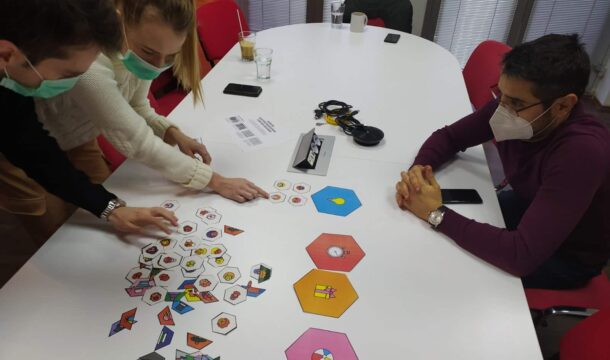А high-performing software development team requires more than gathering skilled individuals.
You can be working on a small-scale MVP or a multi-feature application, but how you combine each role, collaborate or decide on delivery methods will impact the project’s success.
To break this down, we’ll revisit some foundational concepts and dip into:
- The different software development team structures—generalist, specialist, or hybrid
- The roles and responsibilities that shape effective teams
- Best practices for adaptability and collaboration
- The impact of present and future trends
Whether you’re already leading a team or starting from scratch, you’ll gain valuable takeaways and a robust framework for decision-making.
Software Development Team Structure Types
The type of structure should reflect the project’s complexity, timeline, and the value each role brings.
For example, if the project is an internal tool with a highly complex back-end but a simple user interface, you might need specialized back-end developers but less focus on front-end design. Conversely, if user experience is a priority, the roles may tilt towards UX and UI experts.
Additionally, the appropriate structure depends on balancing the project’s scope with the skills and roles that provide the most value. So, in the early stages of project planning and sourcing, worthy questions to ask would be:
- What are the project’s most challenging aspects?
- What areas require deep expertise?
- Where can more generalist roles help reduce costs or streamline efforts?
Also, such planning improves the chances for teams to evolve as the project grows, starting with generalists who can handle multiple roles and bringing in specialists when needed.
A Generalist Development Team Structure
A generalist team has versatile professionals who can handle multiple aspects of the project. This team structure works best for early-stage projects, MVPs, or smaller products where the scope isn’t fully defined yet. Generalists can juggle responsibilities across design, development, and testing, providing flexibility and cost-effectiveness.
Besides, generalist professionals often bring a holistic view, which is valuable in the initial stages of product development. However, they may lack the depth needed for highly specialized tasks.
A Specialist Development Team Structure
In contrast, a specialist team focuses on deep expertise in specific areas. Ideally, this structure is suited to projects where advanced technical skills are needed, such as complex back-end systems, high-performance applications, or security-intensive products.
Specialists excel in highly focused tasks, completing them with greater precision and efficiency. However, a team made solely of specialists may lack flexibility and require strong coordination with other teams.
A Hybrid Development Team Structure
A hybrid team combines the resourcefulness of generalists with the deep expertise of specialists. Generalists can oversee broader project aspects, while specialists handle the more intricate, technical work. Furthermore, this setup’s balance allows the software team to be agile enough to respond to changes while maintaining technical depth.
In addition, hybrid teams often scale better for larger projects that require both flexibility and high levels of technical knowledge. As a result, they tend to be the go-to choice for complex or long-term projects.

Development Team Roles and Responsibilities
Each role in a software development team has a distinct purpose. Naturally, some duties may overlap. But, the ultimate goal is to balance strategic decisions with hands-on work and produce quality outcomes.
Below, we’ll outline the responsibilities of different software development roles and see how they contribute to the broader development process.
Product Owner
Product Owners define the product’s vision and guide its development. They are the primary liaison between stakeholders (internal departments or external clients) and the software professionals building the product.
For internal projects, the PO is often someone from senior management with decision-making authority and deep product knowledge. Conversely, for client-driven projects, the client commonly appoints a Product Owner to represent their vision and priorities.
Responsibilities:
- Set the long-term direction of the product based on business goals and market needs.
- Prioritize and maintain the product backlog and decide what features or improvements to tackle first.
- Act as the primary liaison between stakeholders and the dev team, collecting input and adjusting plans when necessary.
- Regularly review the product’s progress and adapt the roadmap based on market trends or additional feedback.
In many teams, specifically in Agile approaches, the Business Analyst (BA) works closely with the Product Owner to clarify requirements and refine solutions.
While the PO focuses on setting priorities and managing the development roadmap, the BA conducts deeper analysis, translating broad business needs into specific, actionable requirements.
Business Analyst
Business Analysts specify the details that make the product vision actionable. They gather requirements, analyze them, and provide precise guidance to the development team.
Responsibilities:
- Communicate with different stakeholders to identify and document specific needs for the product.
- Collaborate with software professionals to make sure requirements are understood and adjust as necessary based on technical input.
- Help validate that the final product meets the agreed-upon specifications.
- Act as the bridge between technical teams and non-technical stakeholders, ensuring a clear understanding of the product’s goals and the technical work required.
- Continuously revisit and refine the requirements as market needs, business priorities, or feedback shifts.
There’s often confusion between the roles of Product Owners and Business Analysts since their responsibilities can overlap, change or be distinct depending on the methodology, company size, or available resources.
Project Manager
Simply put, a project manager is responsible for delivering the project on time and within scope by coordinating tasks, resources, and teams.
Responsibilities:
- Plan, oversee and adjust project timelines to meet the set milestones.
- Coordinates between cross-functional teams and match efforts across departments—from development to marketing.
- Identify risks early and resolve issues before they cause delays.
- Keep stakeholders informed by providing regular updates on progress and challenges.
- Adjust project plans and timelines as needed to keep the project moving forward efficiently.
In smaller companies, the PM often assumes additional responsibilities, such as those of a Scrum master or service delivery manager, handling project oversight and day-to-day tasks.
Otherwise, these roles are typically distinct, with the project manager overseeing the overall coordination of the project. On the other hand, Scrum masters focus on guiding specific Agile teams or managing individual sprints within those teams.
Software Architect
Software architects are accountable for shaping the software’s structure. They decide how different components interact and concentrate on determining the system’s scalability, performance, and long-term maintainability.
Responsibilities:
- Design the high-level architecture of the software, selecting frameworks, tools, and platforms that would fit.
- Set and implement coding standards, guiding the team on best practices that promote clean, maintainable code.
- Oversee critical decisions such as selecting databases, integration methods, and third-party tools.
- Collaborate closely with developers, technical leads, or other specialized roles such as DevOps that would add expertise for areas like infrastructure automation.
- Monitor the software’s architecture as it evolves, identifying areas for optimization or refactoring to improve efficiency and performance.
More than just a planner, the software architect is a critical decision-maker throughout the Software Development Life Cycle (SDLC). Moreover, senior developers or technical leads may take on some of these responsibilities in smaller setups that don’t have so much leeway with resources.
Software Developer
Software developers, or engineers, transform concepts and requirements into operational and efficient software. They work on different parts of the project and hugely contribute to the creation and improvement of the product.
Responsibilities:
- Develop, debug, and refine software to meet specifications and adhere to standards for writing clean, efficient, and maintainable code as much as possible.
- Collaborate with product owners, project managers, software architects, designers and quality assurance professionals to turn defined ideas and requirements into implementations.
- Address technical issues and troubleshoot during the development lifecycle to keep projects on track.
- Update and improve existing software with adjustments based on user feedback, evolving requirements, and objectives.
- Document code structures and development processes, creating clear guides that support current and future team members.
Different types of developers contribute specific expertise:
- Front-end Developers: Create and handle user interface functionalities that are intuitive, responsive, and consistent across devices.
- Back-end Developers: Manage the server side of applications, handling databases, server logic, and integrations with other services to keep the system running correctly.
- Full-Stack Developers: Versatile in front-end and back-end development, capable of addressing multiple facets of a software project.
If the preference is Agile methodology, developers frequently work within iterative sprints to build, test, and release features in shorter cycles.
Over time, many senior developers transition into tech or team leads, guiding more junior members and managing technical decisions. In small-scale companies, they might also take on responsibilities akin to software architects, advising on broader technical approaches and systems design.
Quality Assurance (QA) Engineer
QA Engineers, also called testers, maintain quality throughout the development cycle. Their duties revolve around detecting issues early on and assuring the product performs as expected across different environments before being released to users.
Responsibilities:
- Design and execute tests to identify issues, glitches, and inconsistencies, simulating how real users might interact with the software.
- Work closely with developers to report bugs, verify fixes, and confirm new or existing features work as intended.
- Automate repetitive testing processes using scripts to simplify the workflow and make quality checks more consistent.
- Log and prioritize defects, working directly with other team members to address and fix critical problems.
- Perform re-tests on fixed areas, confirming that recent updates don’t introduce new issues.
- Keep detailed records of test cases, results, and best practices, providing a reference for future work.
Different specializations exist within QA:
- Manual QA Engineers: Perform hands-on testing to verify user interactions and catch cases that automated tests might miss.
- Automation QA Engineers: Write scripts for automated testing, speeding up the process and covering more test scenarios.
- Performance and Load Testers: Evaluate how the software tolerates various conditions, verifying stability under high traffic or intense use.
Likewise, QA Engineers participate in each sprint and validate features as they are fleshed out. Their involvement is necessary for continuous delivery, where rapid iterations demand frequent, thorough checks.
Depending on the project scale, software tester obligations differ. Sometimes, developers may share testing duties, while larger projects will likely have dedicated QA teams with specialized roles for performance, security, or compliance.
UX/UI Designer
Designers shape the user experience and visual language. In that sense, the position usually combines the creative and technical. There is sometimes confusion over job titles, with debates around what distinguishes a UX from a UI Designer or how a Product Designer fits into the mix. However, all share a common purpose: to design excellent and engaging user experiences.
Responsibilities:
- Gather insights on user behaviours, preferences, and pain points through surveys, interviews, usability tests, and other methods. Use these insights to inform design decisions and refine features.
- Develop wireframes and prototypes that outline the application’s structure, flow, and interactions. These low-fidelity representations help visualize the user journey and plan interactions before full development.
- Design the visual elements of the interface, including colour schemes, icons, typography, and layout. Aim for a cohesive style that guides users intuitively through the software.
- Establish design systems that specify visual standards, reusable components, and design patterns. The purpose is consistency across different application parts and an easier developer handoff.
- Organize content and features logically, designing clear navigation paths that make the software easy to explore. Such elements involve structuring menus, screens, and user flows to match user needs.
- Regularly coordinate with developers, product managers, and QA teams to refine designs based on technical constraints and feedback. Discuss design feasibility, clarify expectations, and adjust plans where needed.
The role of designers varies depending on company size and structure. In smaller teams, a single designer might wear multiple hats, covering research, visual design, and user testing.
Larger companies typically segment these responsibilities, allowing designers to specialize and bring focused expertise to specific areas.
DevOps Engineer
DevOps Engineers set up and manage systems that automate the software flow from development to production. They also build and maintain processes that help move code between different stages and environments, reducing manual effort and delays.
Responsibilities:
- Collaborate with developers to build and refine Continuous Integration/Continuous Deployment (CI/CD) pipelines, which automate merging code changes, running tests, and deploying updates.
- Develop scripts and leverage tools to automate integration, testing, and code deployment, minimizing repetitive manual tasks.
- Include automated security scans within the development workflow to detect and address vulnerabilities.
- Create configurations to manage servers, databases, and other infrastructure through code.
- Continuously monitor application performance, identifying and addressing bottlenecks or issues to keep systems running smoothly.
- Set up containers (like Docker) and other virtualization tools to isolate software environments so that testing and deployment of applications are consistent across different stages.
Commonly, DevOps duties vary based on the scale of the organization. More undersized teams may have developers or QA engineers taking on some DevOps tasks. In contrast, enterprises rely on dedicated DevOps teams to address complex automation, infrastructure management, and large-scale deployments.

Best Practices for a Successful Software Development Team
Following up on the previous section, here are some actionable tips to take into account for building and managing a high-performing software dev team:
Tailor to Project Demands
The team composition should reflect the current circumstances:
- Early-stage projects: Start with generalists who can handle multiple roles and iterate quickly.
- Growth phases: Introduce specialists to address performance, security, or additional technical aspects.
- Larger-scale projects: Adopt a hybrid structure, blending the generalist’s flexibility with the specialist’s expertise.
Align with Phases and Resources
The stage that you’re in and the available resources dictate the structure:
- Limited resources? Lean on a generalist-heavy team to manage multiple tasks efficiently.
- Growing budget? Bring in specialists like DevOps as the project matures.
- Enterprise-level ambitions? Integrate more specialized roles and higher-level oversight to handle increased complexity.
Balance Expertise and Methodologies
Encourage knowledge-sharing to break silos and opt for project management methodologies to suit your team’s distinct dynamics:
- Promote knowledge-sharing: Specialists can share their expertise to upskill generalists and vice versa, building a more versatile team.
- Agile software development team structure: Use Agile methodologies as a guide, not a rulebook. Consider adopting a hybrid approach instead of rigidly sticking to specific frameworks.
Prioritize Clarity and Transparency
Clear communication is essential to managing evolving teams:
- Create a structured flow: Regular stand-ups, retrospectives, and status updates bring everyone on the same page.
- Use project management tools wisely: Platforms and apps simplify communication but should not replace face-to-face interactions. Concentrate on open and actionable discussions, not just tooling.
Monitor and Adjust
Consider adaptability front and centre:
- Track performance: Regularly assess performance to identify bottlenecks or areas needing improvement. Whether promoting a developer into a leadership role or adding specialists, adjustments should be proactive.
- Refine Setup: If some positions or configurations don’t perform as expected, reassess and make the necessary changes. Flexibility in structuring your team is a strategic advantage, allowing for quick responses to shifting demands.
Final Thoughts
As technology advances and business needs shift, the way software development teams operate continues to change.
One major trend is the growing role of AI and automation. Consequently, we’re seeing a demand for professionals who can wear multiple hats with AI tooling as a support layer. However, this is far from being the complete solution or upgrade. These tools often work in isolation and produce challenges to share company-specific knowledge or handle more nuanced tasks.
In parallel, outsourcing trends with models like nearshore software development are constantly gaining momentum. They’re no longer seen purely as a cost-cutting measure but as strategic decisions to access specialized talent and stay competitive. Businesses are realizing that working with distributed partners could bring the best of both worlds—cost-effectiveness and successful collaborations.
As a software development company, we’ve seen firsthand how the right team structure and strategic approach can lead to lasting success for clients. If you seek to build or refine your software development team, we’re open to sharing insights from our experience and helping you get started.



